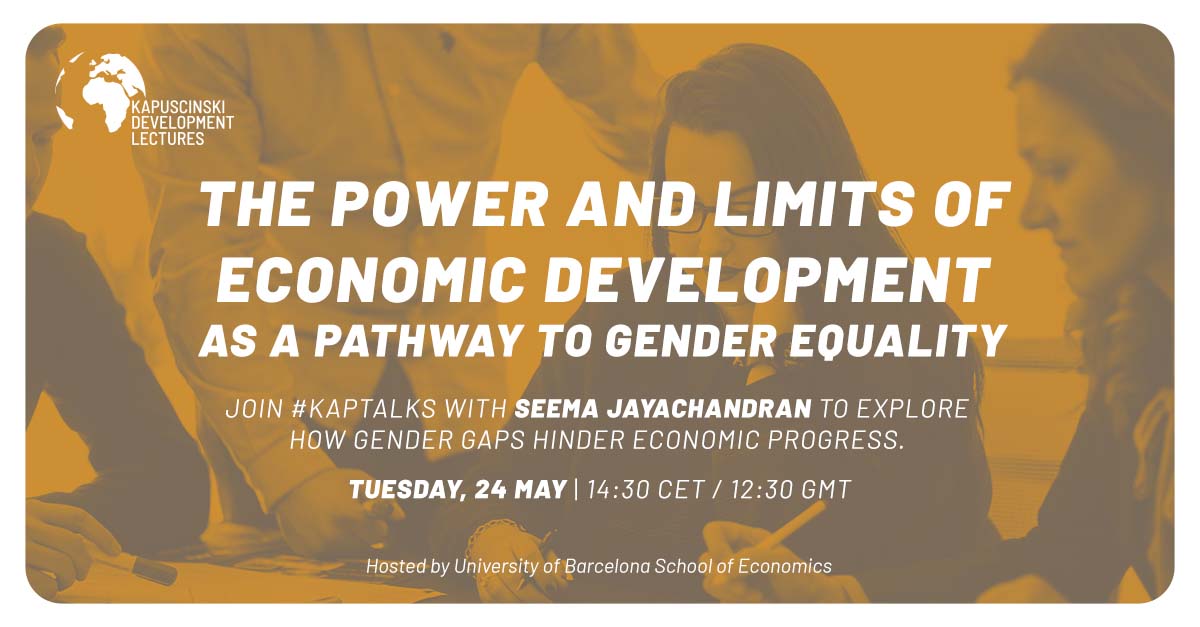The power & limits of economic development as a pathway to gender equality
May 24, 2022

As economies develop, women and girls have a comparative advantage in those jobs that require brains rather than brawn.
Seema Jayachandran is an economist whose research focuses on environmental conservation, gender equality, health, and other microeconomic topics in developing countries. In advance of her Kapuscinski Development Lecture she spoke about how gender equality feeds economic progress and vice versa.
Gender equality matters. Of course, the first reason is a matter of human rights - we want everybody to have opportunities and access to education and health care.
But it also matters for economic development.
There's evidence that when women and girls have more opportunities, that makes the whole economy larger and helps lift everybody into a higher standard of living. The gender gaps in access to health care and education, for example, are going to hurt the economy as a whole and widen gender gaps in access to economic resources.
Vice versa, economic progress can help bring about gender equality.
One reason is the way the economy moves away from agriculture and heavy industries, towards services, through the process of economic development. That helps women and girls, who have a comparative advantage in those jobs that require brains rather than brawn, increasing their earning potential.
Also, as household chores become less time-intensive through technological advances, household income can increase. Because the responsibility for chores typically falls to women, these advances free up women’s time to seek outside work.
Another reason is declining fertility rate and increases in access to family planning services. With a smaller family size and more control over when they have children, women can spend more time in the labor force and more easily pursue careers that require several years of upfront training.
These changes all increase women’s earnings, which begets gender equality in other arenas. For example, parents invest more in their daughters’ education if they expect her to earn a return on that educational investment in the labor market.
Some of the same policies and forces that help economies develop also help narrow gender gaps along the way. But there are limits to that. We might not want to wait decades or centuries for that economic transformation to happen, we might want equality right now. But even more importantly, there are many cases where despite that economic transition, those gaps aren't narrowing. They might even get worse before they get better. Often, those are cases where cultural norms are at play.
For example, in India, one norm is the desire to have sons rather than daughters. You might think as the economy moves towards services, and women are on an equal footing with men in terms of their economic earning power, parents would start to want to have daughters as much as sons. That's not necessarily true, however, because the reasons to want to have sons isn't just because of their earnings. It's because of religious reasons, centuries old traditions and status that come from having a son.
So we need to look at the interplay between the economic forces and the cultural forces to understand whether gender gaps will close. And sometimes, unfortunately, the economic progress just isn't enough.
Even if gender gaps might close “on their own” through economic growth, there is an important role for public policy to address gender inequities. There are two ways policymakers can address the challenge of cultural norms.
One is to be thoughtful when designing policies in light of those norms. The standard business training program or education model might not work. And you need to think what tweaks in the design might make them more effective, so that they're compatible with conservative norms and still enable women and girls to thrive. The second and more ambitious approach is to try to change a society’s restrictive gender norms. When a norm is standing in the way of equal rights, I think it's completely okay and right for policymakers to say I want to move my society towards having more equal rights.
If girls had better access and equal rights to education, if women had better maternal health care, better health care in general, they would be not only healthier and more educated, but more productive in the economy. There's been a lot of progress in expanding access to childcare. We might think that's gender neutral, but we all know that women do most of the childcare. So access to affordable childcare enables women to pursue the careers they want to pursue, earn more money, get more power and equality in society. And so that kind of policy is not just good for families overall. It's also helping to even the playing field between men and women.
That’s the economic motivation for wanting to narrow these gaps in human capital. And of course, gender rights are human rights. So narrowing the gaps is valuable in and of itself.
For more info about her lecture 24 May, visit https://bit.ly/Jayachandran. The lecture will be hosted by the University of Barcelona and streamed live online. Register here.
The Kapuscinski Development Lectures are jointly organized by UNDP, the European Commission and partner universities, bringing top global thinkers to discuss development topics with university students and the public.


 Locations
Locations